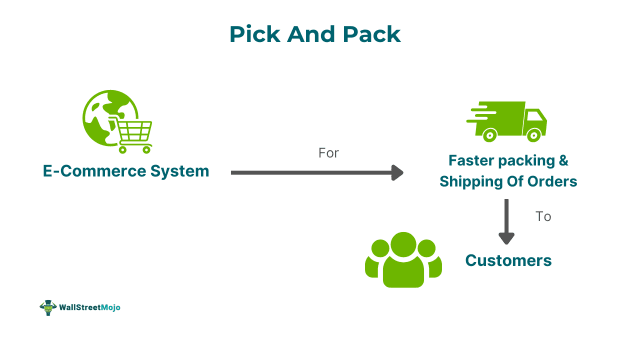Table of Contents
What Is Pick And Pack?
Pick and pack refers to a system of accepting orders from customers and immediately putting them into dispatch for shipping. It serves as a vital tool for e-commerce retailers, eliminating the necessity of shipping repacking and allowing faster packing and delivery of small orders.

It has numerous uses in e-commerce, like enhancing order accuracy, reducing labor costs, and speeding up delivery. Hence, it improves operational effectiveness and customer satisfaction in retail settings. It can be done using various methods, such as piece, zone, batch, and wave picking.
Key Takeaways
- Pick and pack represents a crucial e-commerce system that hastens the shipping process by immediately accepting customer orders and eliminating the necessity for repacking.
- It involves four steps- receiving an order on WMS, picking up the item by staff, packing it, and shipping it to the customer.
- Its strategies include- maintaining labeled shelves, placing frequently purchased items together, keeping fast-paced items close, executing kitting, and training staff for efficient handling.
- It improves customer satisfaction and service owing to highly accurate and faster order completion, but ongoing inventory maintenance costs and the initial startup of automated WMS could become too costly.
Pick And Pack In Warehouse Explained
Pick and pack represents a procedure where goods are chosen from the stock to be placed in the packaging box for further shipment. It enables streamlining of order fulfillment using consolidated packing and picking activity into a single ongoing operation. It begins with the lost to pick items, which have details of items in an order. Then, the worker explores the warehouse to take out the items for picking and takes them to a packing point for secured packaging inside custom boxes or standard shipping containers, depending on the brand’s fulfillment strategy.
It has ushered the e-commerce landscape into a speedier and more accurate era for handling a variety of items ordered and delivered in a timely and efficient manner. Businesses have used them as per their size and volume of orders in the following manner:
- Piece Picking: Used by small businesses having low order quantities.
- Batch Picking: Helps group orders and optimize picking routes.
- Zone Picking: Designates picking staff to particular warehouse zones.
- Wave Picking: Deploys zone and batch picking for greater efficiency.
Moreover, it has implications like decreased operational costs of warehousing, which account for 70% of net costs while handling higher order volumes. If executed properly, it facilitates accurate and timely fulfillment of orders, increasing the satisfaction of consumers and brand loyalty. It has also led to reduced labor costs and decreased costs with higher customer loyalty.
Further, the efficient packing and picking process reduces operational expenses and enhances profitability significantly. It also helps retain a competitive edge.
Process Steps
The entire process of picking and packing happens in four steps, as shown below:
- Receiving the order: s soon as the customer books an order for an item, the warehouse's management system (WMS) creates a packing note with order details printed and assigns it to a worker to pick it up.
- Picking the order: After that, the designated staff uses the correct machinery and reaches the right shelves or location to pick the item ordered in the needed quantity of every item and authenticate them from the picking list.
- Packing the order: Then, the orders that are picked move to the packing station for the staff to pack them and seal items into the correct boxes. Moreover, the boxes are labeled, checked for accuracy, given to the stage, and picked up by carrier concerning loading docks.
- Shipping the order: Staff then organizes packages at loading docks' staging areas and takes them to a particular dock door when assigned carrier trucks related to customer deliveries arrive.
All the above steps help e-commerce retailers achieve quick, highly accurate warehouse operations and fulfillment.
Strategies
Let us discuss some strategies regarding effective picking and packing:
- Keep fast-paced items closer to the packing station to facilitate quick packing and shipping.
- Place frequently purchased together items near each other to enable easy picking.
- Execute kitting using a combination of commonly purchased together items into one package.
- For easy access and location to items, one must maintain labeled and organized shelves.
- Train the existing and hire new staff to make them knowledgeable, apt, and efficient to handle the job's demand effectively and sustainably.
Examples
Let us use a few examples to understand the topic.
Example #1
An online article published on 23 July 2024 discusses the increasing demand for e-commerce within South Carolina. A robust business environment, advanced logistics systems, and strategic locations have steered it. Further, the logistics entailing effective picking and packing have become crucial for timely and accurate order fulfillment, affecting consumer satisfaction significantly. Other than that, local businesses have been flourishing along with giants like Walmart and Amazon.
Picking and packing have greatly transformed with the use of automation, IoT, and AI, increasing accuracy and efficiency. However, some challenges have persisted, like infrastructure needs, high costs, and workforce training. According to an estimate, robotics, data analytics, and blockchain are some of the trends that will revolutionize logistics to respond to personalized and faster customer demands.
Example #2
Let us assume that Wrangling Danger, an e-commerce retailer in Old York, gets an order for three items from Joey Jane: a cookbook, a blender, and a glassware set. The order then passes on to the retailer's warehouse in Old Jersey. After that, the worker Joseph, working in pick-and-pack fulfillment, asks for the pick-up list created in the system. Next, he moves around the aisles and starts picking up the desired items from their locations.
As soon as Joseph collected the items, he carried them to the warehouse's packing point to securely pack them with bubble wrap and packaging. Then, he labeled those items and gave them to the courier for pick-and-pack shipping. Thus, the staff Joseph made sure the items were promptly dispatched to the customer. As a result of excellent pick-and-pack services, Joey happily received them within three days in secured condition.
Best Practices
Below listed are some tested and tried solutions that would enhance the picking & packing system:
- Plan a route for efficient picking based on the volume, type, size, and layout of items kept in the warehouse, decreasing order closing time.
- Using an inventory management system enhances packing and picking speed and stores high inventory closer to packing stations.
- Implementing mobile barcode scanners improves picking accuracy, recommends optimal routes, and minimizes errors and highly costly manufactured mistakes.
- Optimize inventory control, automate workflows, and aid in increasing sales volume and sophisticated orders using WMS.
Advantages And Disadvantages
For small e-commerce companies and retailers, it offers certain pros and cons, as listed in the table below;
| Advantages | Disadvantages |
|---|---|
| It improves customer satisfaction and service due to highly accurate and faster order completion. | Ongoing inventory maintenance costs and the initial startup of automated WMS could become too costly. |
| Decreases labor costs while increasing productivity with the help of automated WMS. | All types of items and warehouse designs may not suit the use of automation. |
| Pick-to-light and barcode scanners increase picking accuracy and minimize errors. | In case of an internet slowdown, system failure can result in downtime of automation. |
| It gives sufficient flexibility to expand operations to fulfill customer demand and manage sophisticated orders effectively. | Unmonitored and unoptimized manual processes could lead to inevitable human errors that effects the entire process. |

